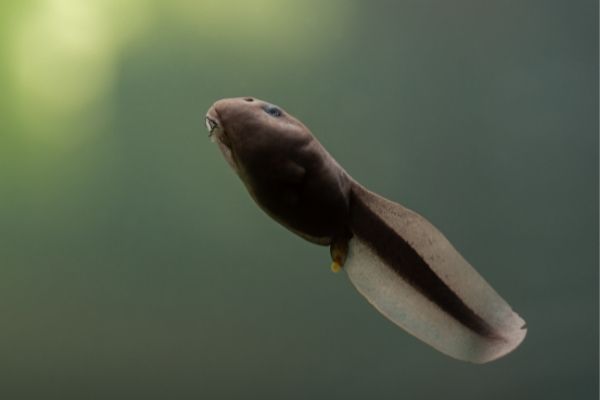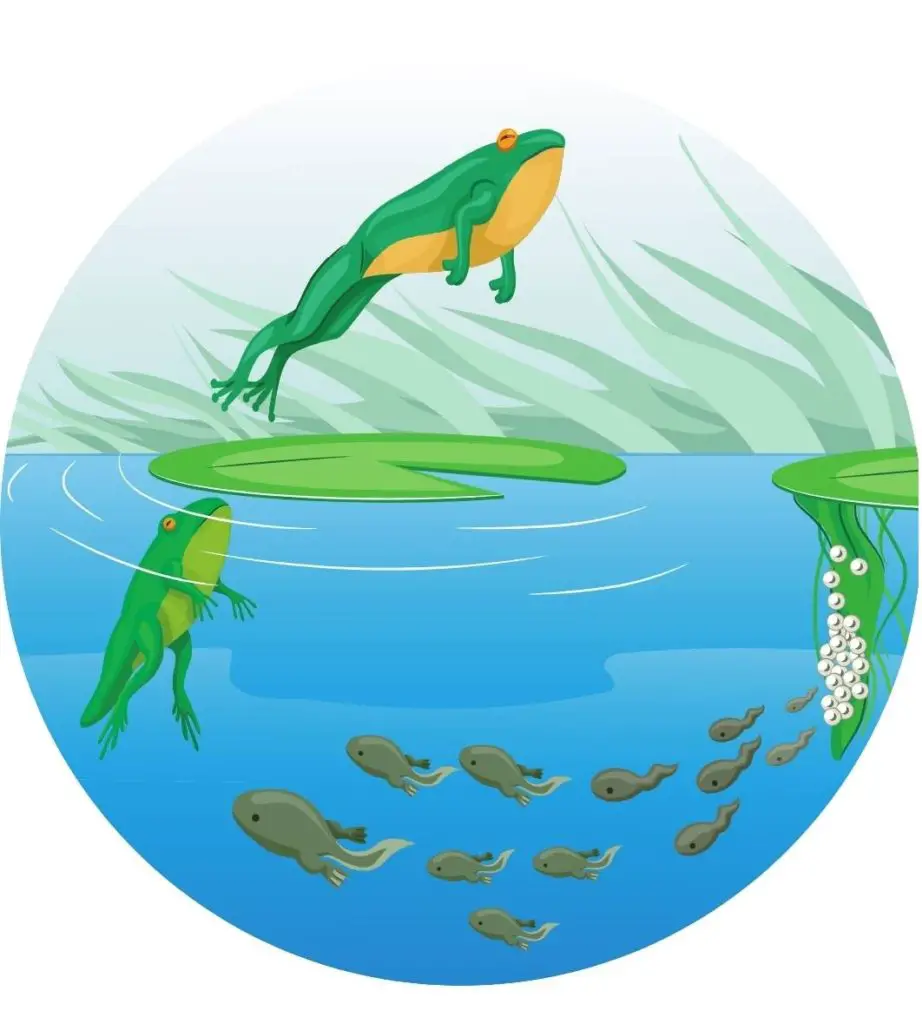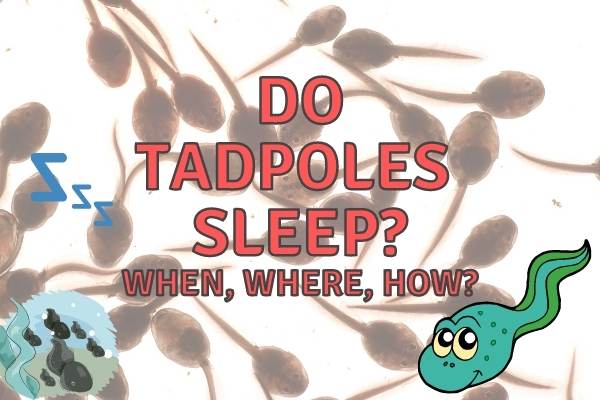A tadpole is the larvae stage of the frog life cycle. They do not swim around all the time to look for food as their body needs rest to recover and conserve energy.
Tadpoles get most of their sleep at night. Like most small aquatic animals, tadpoles sleep in small bursts during night and day to keep alert of their surroundings. However, studies show that they are indeed more active in brighter conditions and sleep more when it is dark.
Tadpoles are aquatic most of their lives and they live in freshwater. Because tadpoles are the early stage of being a frog, it does not exhibit the specific lung physiology that allows them to venture onto land.
And as tadpoles mature, they begin to change—from spending all their time underwater, they begin to breathe air and walk onto land for the first time – they turn into frogs!
So whereas adult frogs can sleep in many different places, including underwater for aquatic frogs, in trees for arboreal frogs, and underground for terrestrial frogs, tadpoles have to stay underwater.
Contents
How do tadpoles sleep?
Tadpoles have a more difficult existence than frogs because they are still considered undeveloped and minor. Because most are not pets and therefore live in a pond or lake that is located in the wild, they are being hunted by many species, day and night.
This means that their sleep is complicated because they have to be alert all day and night in order to keep any potential hazard they might face.
Therefore, tadpoles are light sleepers since even the slightest sounds can disturb them, which also means they rest by taking short naps lasting minutes rather than hours.
Do tadpoles sleep upside down?
Tadpoles have been observed to sleep upside down, but this is not normal. Ironically, because tadpoles eat a lot of bacteria, their swimbladder sometimes gets infected which leads to the accumulation of air which causes the tadpole to turn upside down. This does not mean that they are sleeping like this!
They normally just float in a static position in the water either near the bottom or in some type of vegetation to hide.
Because tadpoles have predators coming for them, they need to be aware all of the time. So, sleeping upside down could be a benefit when predators lurk mostly from below, but this has not been scientifically proven yet.
Do tadpoles sleep on their side?
There are no concrete pieces of evidence proving that tadpoles can sleep on their side. However, tadpoles sometimes exhibit sideways motions when they sleep.
This leads the infecting bacteria to form gas that will eventually fill the swim bladder and therefore disrupt the tadpole’s ability to control the gas content in their swim bladder and keep their preferred position in the water.
If the tadpole does not get rid of the bacteria in the swim bladder, they may have so much gas that they stay chronically upside down or on their side – also when they sleep!
This is not a benefit to the tadpole, and they will eventually die due to their difficulties in moving freely around that limits their ability to find food and escape predators.
When do tadpoles sleep?
Tadpoles mostly sleep at night. Like humans, they get tired swimming around and looking for food, and night is a good time to sleep as predators are less active and food is harder to find.
However, they also sleep during the day, but the light seems to have a say in their sleeping rhythm.
During the day, tadpoles prefer a natural light that is not too bright and not too dark, enough for them to see their food and keep an eye on predators, even though they still do not have fully developed eyes.
Furthermore, during the night, tadpoles became very sensitive to light and if you keep tadpoles in an aquarium there should be no light at night, otherwise, they get too little sleep, which may keep them too active with less energy going to their development and growth.
Do tadpoles require light?
Biologically, tadpoles do not require light as such, but they are more active during the day or when provided with artificial light.

They prefer bright conditions because their eyes are not very sensitive and they need to be able to detect predators or potential food items.
Are tadpoles active at night?
Tadpoles are active during the night and during the day, but mostly during the day. Some research states that some tadpoles are more active at night because they adapt to the dark, however, generally they are most active during the day.
In the daytime, tadpoles seek out brighter conditions near the water surface. Here, they will be able to more easily spot predators living on the bottom such as freshwater crabs and crayfish that are known to eat tadpoles!
Another reason why tadpoles are more active in the daytime is because of the heat, which makes their bodies and metabolism more active. But they also detect the light directly through their eyes to become more active just like humans produce less sleep hormone during exposure to light, tadpoles are also less likely to sleep during daylight.
Where do tadpoles go at night (Where do tadpoles sleep)?
At night, tadpoles hide in between plants, roots, or cracks in the water where they live. They try to hide behind objects and mostly stay near the bottom where predators from above cannot reach them.
Because they cannot easily go on land before they develop into frogs they will stay in the lake, pond, river, or creeks where they live. They can also be found in places with water like swamps or even puddles.
For how long do tadpoles sleep?
Tadpoles sleep in smaller intervals of a few seconds and up to an hour before they wake up shortly to sleep again. They likely only sleep a total of a few hours during the day.
They do not have much time for sleep as they need to stay alert and they need to spend a lot of time feeding to grow enough. They have a high demand for nutrients during their tadpole stage because they grow quickly into the frog stage, where they sleep a bit more as their growth halts.
The exact amount of time that tadpoles sleep is yet to be discovered, and it is quite a complicated question because it will also depend on their development stage. But frogs sleep up to 16 hours a day, and tadpoles are assumed to sleep much less than that, so one can imagine that they will sleep only a few hours early on and assume similar sleeping habits to the frog in their latest stages.
Sleep during the developmental stages of tadpoles
Stage 1: Eggs – this is the mass of eggs of a frog, its physical features include black dots, which are cells for the tadpoles hatch from. Here they can be considered sleeping most of the time, although sleep cannot be clearly defined at this stage.
Stage 2: Tadpoles – Tadpoles emerge from the eggs after several days. They emerge in freshwaters while developing their physiology for the next process. Here they do not sleep much as they need to forage for a lot of food to grow.

Stage 3: Tadpoles with front and hint legs – this stage is where the organs and body parts of the frog start to appear. It develops over a few days, after which the tadpoles are ready to be frogs. They still need to forage a lot at this stage but are now bigger and therefore considered prey to fewer animals. This allows them to feel safer and sleep more – up to a few hours a day.
Stage 4: Froglets – after the growth of the tadpole’s body part, this is where the froglet develops and is ready to live on land if not a fully aquatic species. Here they take on the sleeping habits of an adult frog and may sleep for hours at a time.
Stage 5: Adult Frogs are fully grown and may hide in trees, holes, or underwater to sleep up to 16 hours a day.





